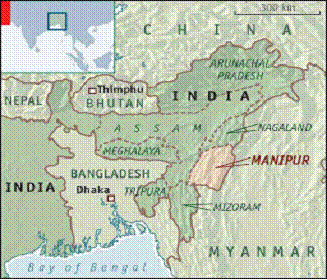home > MAnipur
About Manipur
Manipur is one of eight mountain and valley states in the North East Region (NER) of India. It is nestled in the mountains of the Southeastern Himalaya that rise up to 10,000 feet next to Burma (Myanmar). The size of New Jersey or Israel, it is one of India's poorest states. Its capital Imphal is a degree north of the Tropic of Cancer.
 The NER is a region about the size of Spain, and with a total population of about 40 million, of which 25m of which are in Assam and the remaining 15m in the seven other states. It is attached to the rest of the country by the 20 km wide Siliguri Corridor, and shares international borders with five countries: Nepal, Bhutan, China, Myanmar, and Bangladesh.
The NER is a region about the size of Spain, and with a total population of about 40 million, of which 25m of which are in Assam and the remaining 15m in the seven other states. It is attached to the rest of the country by the 20 km wide Siliguri Corridor, and shares international borders with five countries: Nepal, Bhutan, China, Myanmar, and Bangladesh.
Like most of the people of the mountain and foothills of this region, Manipuris are part of the Tibeto-Burman ethno-linguistic minority that forms about 3% of the total population of India. Manipuris number 2.2 million, about 1.5 million of which are Meiteis who inhabit the central valley. The rest are Naga and Kuki tribes who live in the surrounding hills.
Historic Manipur, the Vaishnav Hindu kingdom of the Meiteis, was known as Meckley, Mekhala and Kangleipak, and is one of four historic kingdoms of NER that also include Sikkim, Ahom, and Tripura. Though it had not been a part of previous Indian empires, the kingdom, 2000 years old according to its Court Chronicle, became a part of British India in 1891. With the departure of the British after WW2, it acceded to India in 1949 upon the dissolution of its Constituent Assembly.
Manipur is known for its performers and athletes. It is the birthplace of modern polo, played on the endangered Manipuri Pony, one of India's five equine breeds. Its warrior culture has produced five forms of martial arts, which also provide a foundation for Manipuri, one of the four classical dance forms of India. The culture is part Southeast Asian and part South Asian, following the region's geopolitical location and watershed topographical character.
Travel to Manipur was, until recently, restricted for foreign nationals because, like much of the NER, Manipur has an armed separatist movement. Still remote, largely untrammeled, and virtually unknown, and lying on one of the historic minor Silk Roads to China, Manipur is now rapidly opening up as the country's Gateway to Southeast Asia under the country's Act East Policy.
FOLLOW US





